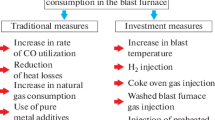The data on the energy intensity, carbon dioxide emission, and end-to-end emission (carbon footprint) for the production of vanadium iron in coke-fired blast furnaces with injection of either natural gas or both natural gas and pulverized coal are presented. Energy intensity is represented by end-to-end process fuel number. Mean values, variance, standard deviation, range of variation of process fuel number, emission, and end-to-end emission of carbon dioxide are calculated using published data on the consumption of coke, natural gas, and pulverized coal in a blast furnace. It is shown that the process with injection of pulverized coal has better performance in terms of energy intensity. Carbon footprint is minimum when injecting natural gas only.

Similar content being viewed by others
References
S. A. Zagainov, B. S. Tleugabulov, V. A. Mikhalev, et al., “Pulverized-coal fuel can successfully be applied in blastfurnace smelting of titanomagnetites,” Byull. Chern. Metallurg., No. 3, 42–46 (2014).
Yu. V. Ovchinnikov, O. K. Grigor’eva, and A. A. Frantseva, Energy Efficiency in Thermal Engineering and Technologies, Izd. NGTU, Novosibirsk (2015).
V. G. Lisienko, Yu. N. Chesnokov, and A. V. Lapteva, “Comparative ecological and greenhouse analysis of alternative coke-less processes for making pig iron and steel,” Metallurg, No. 7, 40–45 (2011).
Yu. I. Rozengart et al., Thermal Power of Metallurgical Plants, Metallurgiya, Moscow (1985).
Yu. N. Chesnokov, V. G. Lisienko, and A. V. Lapteva, “Mathematical models for indirect estimations of CO2 emissions in some metallurgical processes,” Stal, No. 8, 74–77 (2011).
Yu. N. Chesnokov, V. G. Lisienko, and A. V. Lapteva, “Graph model for carbon dioxide emissions from metallurgical plants,” Metallurg, No. 12, 23–26 (2012).
Yu. N. Chesnokov, V. G. Lisienko, and A. V. Lapteva, “Evaluating the carbon footprint from the production of steel in an electric-arc furnace,” Metallurg, No. 9, 23–26 (2013).
Author information
Authors and Affiliations
Corresponding author
Additional information
Translated from Metallurg, No. 3, pp. 23–26, March, 2017.
Rights and permissions
About this article
Cite this article
Lisienko, V.G., Lapteva, A.V., Chesnokov, Y.N. et al. Comparative Analysis of the Influence of Fuel Injection on the Energy Intensity and Carbon Footprint of the Blast-Furnace Process. Metallurgist 61, 183–187 (2017). https://doi.org/10.1007/s11015-017-0474-0
Received:
Published:
Issue Date:
DOI: https://doi.org/10.1007/s11015-017-0474-0




